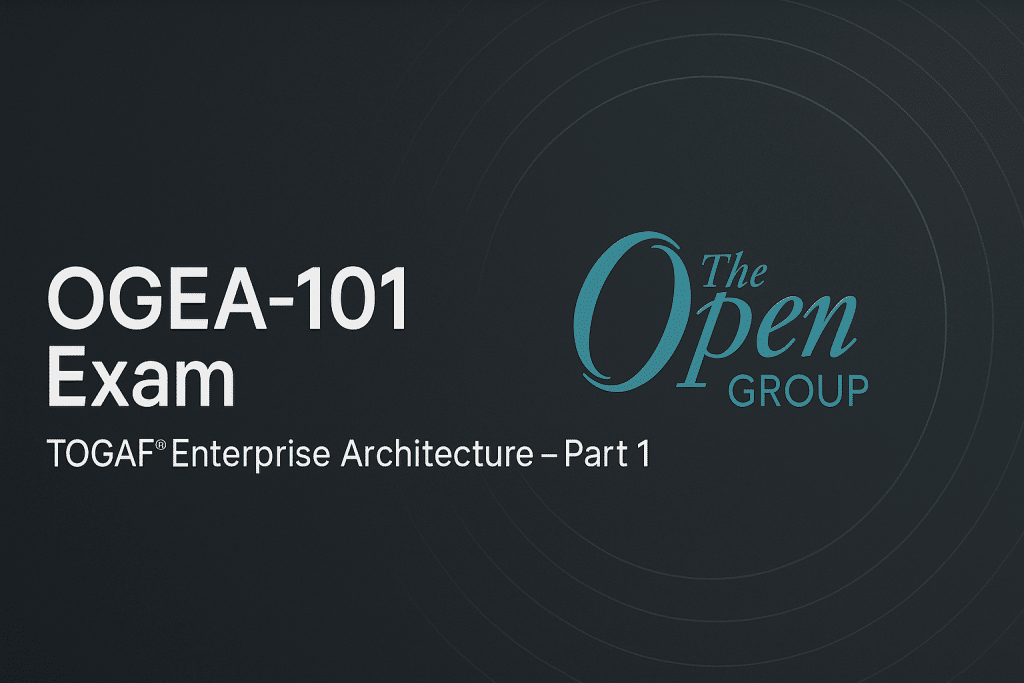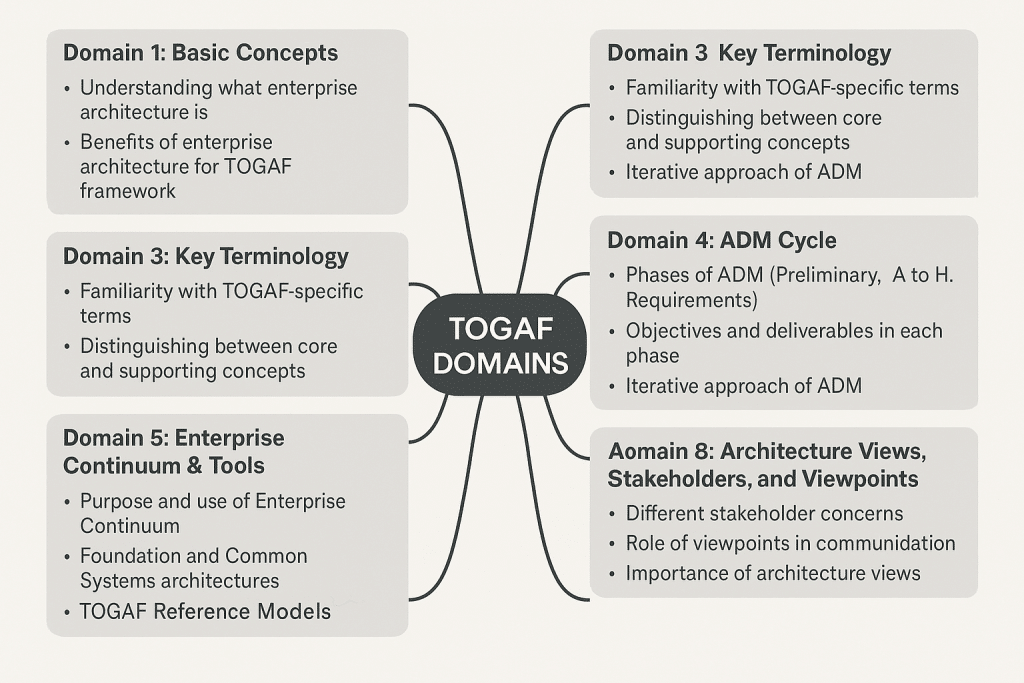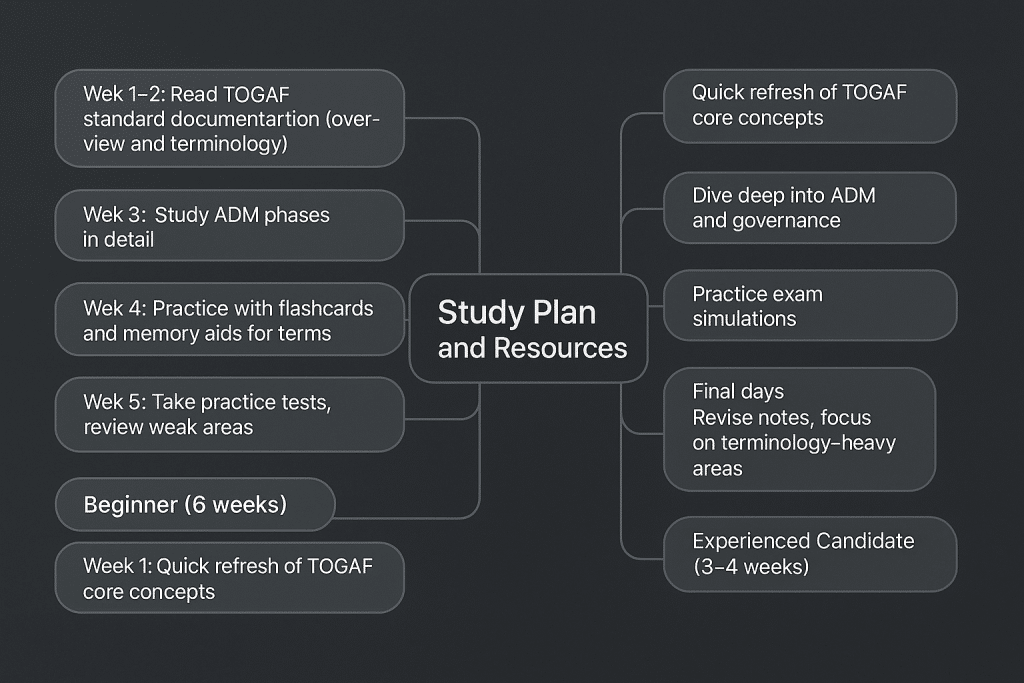
What is The Open Group OGEA-101 Exam?
The OGEA-101 exam is the official certification test for the TOGAF 9 Part 1 Foundation credential, issued by The Open Group. It validates your basic knowledge of the TOGAF framework, which is the most widely used enterprise architecture methodology in the world. Passing this exam demonstrates that you understand TOGAF terminology, structure, and key concepts, essentially proving you have a strong foundation in enterprise architecture.
Who should take this exam?
The OGEA-101 exam is designed for professionals who are either entering the enterprise architecture field or work in roles where understanding TOGAF is essential.
Typical candidates include:
- Enterprise Architects (junior or aspiring)
- Business Architects
- IT Architects and System Architects
- Technology Managers and Project Managers who work with EA teams
- Consultants supporting digital transformation projects
- Analysts and Developers who want to step into architecture roles
Experience level:
- Often the first step for IT professionals with 1–3 years of exposure to IT architecture or business transformation initiatives.
- Suitable for beginners with no prior TOGAF certification.
Prerequisites and recommendations
Official prerequisites:
- None. Anyone can register and attempt the exam.
Practical recommendations:
- Experience level: At least 1–2 years in IT or business-related projects makes the content easier to absorb.
Knowledge of IT/business systems (basic exposure to enterprise systems, business processes, or IT frameworks).
Prior certifications helpful but not required: ITIL Foundation, PMP, or CompTIA Project+ for context.
Exam objectives and domains
The OGEA-101 exam is structured around basic TOGAF knowledge.
- Basic Concepts
- Core Concepts of TOGAF 9
- Key Terminology
- ADM (Architecture Development Method) Cycle
- Enterprise Continuum & Tools
- TOGAF Reference Models
- Architecture Governance
- Architecture Views, Stakeholders, and Viewpoints
Objective details by domain

Domain 1: Basic Concepts
- Understanding what enterprise architecture is
- Benefits of enterprise architecture for organizations
- The purpose of the TOGAF framework
Domain 2: Core Concepts of TOGAF 9
- Definitions of architecture domains (Business, Data, Application, Technology)
- Enterprise Continuum basics
- ADM’s role within TOGAF
Domain 3: Key Terminology
- Familiarity with TOGAF-specific terms
- Distinguishing between core and supporting concepts
Domain 4: ADM Cycle
- Phases of ADM (Preliminary, A to H, Requirements)
- Objectives and deliverables in each phase
- Iterative approach of ADM
Domain 5: Enterprise Continuum & Tools
- Purpose and use of Enterprise Continuum
- Foundation and Common Systems architectures
- Tools supporting architecture development
Domain 6: TOGAF Reference Models
- TRM (Technical Reference Model)
- III-RM (Integrated Information Infrastructure Reference Model)
Domain 7: Architecture Governance
- Concept of governance in architecture
- Compliance and stakeholder accountability
Domain 8: Architecture Views, Stakeholders, and Viewpoints
- Importance of architecture views
- Different stakeholder concerns
- Role of viewpoints in communication
What changed in this version
- Updated to align with TOGAF 9.2 (latest revision).
- Some terminology simplified for easier understanding.
- Greater emphasis on governance and stakeholder views.
- Reduced weight on outdated reference models.
- More scenario-style questions, less rote memorization.
Registration and scheduling
- Register via The Open Group website or authorized testing partners like Pearson VUE.
- Choose online proctored exam or in-person testing center.
- Flexible scheduling, available year-round.
Pricing and vouchers
- Standard price: $360 USD (may vary by country).
- Regional pricing differences: Lower rates may apply in emerging markets.
- Discounts available for:
- Corporate voucher programs (through employers or training partners)
- Students with valid ID
- Military/veterans (region-dependent)
Policies you should know
- Retake policy: 60-day wait period after a failed attempt.
- Cancellation: Must be done 48 hours before the exam.
- ID verification is mandatory for both online and in-person exams.
Scoring and results
- Scoring scale: 0–100%
- Passing score: 55% (22 out of 40 questions)
- Question type: Multiple-choice, single-answer
- Results: Delivered immediately after the exam
- Score report: Available online in your Open Group account
Exam day and test experience
- On-site exam: Present valid ID, empty pockets, locker for belongings.
- Online exam: Remote proctoring via webcam, ID check, quiet environment required.
- Allowed items: None (scratch paper and online calculator provided).
- Breaks: No unscheduled breaks allowed.
- Interface tips: Flag questions, manage time (40 questions in 60 minutes).
- Time management advice:
- Flag tricky ones and return later.
- Spend max 90 seconds per question.
Study plan and resources

Beginner (6 weeks)
- Week 1–2: Read TOGAF standard documentation (overview and terminology).
- Week 3: Study ADM phases in detail.
- Week 4: Practice with flashcards and memory aids for terms.
- Week 5: Take practice tests, review weak areas.
- Week 6: Do timed full-length mock exams.
Experienced Candidate (3–4 weeks)
- Week 1: Quick refresh of TOGAF core concepts.
- Week 2: Dive deep into ADM and governance.
- Week 3: Practice exam simulations.
- Final days: Revise notes, focus on terminology-heavy areas.
Certification validity and renewal
Certification is valid for life (does not expire).
No mandatory renewal, but professionals often move on to OGEA-102 (TOGAF Part 2) for advanced certification.
Career outcomes
Common job titles:
- Junior Enterprise Architect
- IT Architect
- Business Analyst
- Solutions Architect (entry-level)
| Job Role | Typical Responsibilities | Average Salary Range (USD) |
|---|---|---|
| Junior Enterprise Architect | Assist in developing enterprise architecture, document TOGAF processes, support ADM phases | $80,000 – $100,000 |
| IT Architect | Design IT solutions, align technology with business strategy, ensure compliance with TOGAF | $90,000 – $115,000 |
| Business Analyst | Analyze business needs, document requirements, support architecture teams | $70,000 – $95,000 |
| Solutions Architect (Entry) | Create solution designs, integrate applications, align with enterprise architecture models | $95,000 – $120,000 |
| Technology/Project Manager | Manage IT transformation projects, coordinate with architecture teams | $90,000 – $110,000 |
| Enterprise Architecture Consultant | Provide TOGAF-based guidance to clients, support digital transformation initiatives | $100,000 – $130,000 |
| Senior Enterprise Architect* | Lead EA strategy, governance, and roadmap (often requires OGEA-102 or higher experience) | $120,000 – $150,000 |
Related or next-step certifications
OGEA-102 (TOGAF Part 2): Builds on Part 1, focusing on practical application.
ArchiMate Certification: Complements TOGAF by focusing on modeling.
ITIL, PMP, or AWS Solutions Architect: Great add-ons for specialized career paths.
How does this exam compare to similar certifications
OGEA-101 vs ITIL Foundation: OGEA focuses on enterprise architecture, while ITIL is about IT service management.
OGEA-101 vs AWS Cloud Architect Associate: OGEA is framework-agnostic and strategic; AWS certs are vendor-specific and technical.
Final Words: Get Ready to Pass OGEA-101
The OGEA-101 exam is your first step into enterprise architecture certification. With the right study plan and practice, it’s highly achievable and it opens doors to higher-level roles and certifications.
To boost your preparation, start with these resources:
Frequently Asked Questions (FAQs)
Do I need professional architecture experience to pass OGEA-101?
No, you don’t need prior hands-on experience as an enterprise architect to pass OGEA-101. The exam is designed as a foundation-level certification, so it focuses more on your ability to recognize and understand TOGAF concepts rather than applying them in real-world projects. Having IT, project management, or business process knowledge can make studying easier, but it is not required.
What languages is the OGEA-101 exam available in?
The exam is primarily offered in English, but depending on your testing region, you may also find localized versions in languages like Japanese, French, or Chinese. It’s best to confirm availability when scheduling through Pearson VUE, as not all test centers support multiple languages.
Does OGEA-101 include scenario-based questions?
Most of the questions in OGEA-101 are knowledge-based, testing your memory of terminology and definitions. However, a small portion includes light scenario-style questions where you are asked to choose the correct TOGAF concept or ADM phase for a given situation. These are simpler than the more advanced scenario questions you’ll see in Part 2 (OGEA-102).
Can I pause the exam or take a break during the test?
No unscheduled breaks are allowed once your exam session begins. If you step away from your computer or testing station during the exam, your session may be terminated. For online testing, this rule is even stricter since you are under live proctoring.
Is there negative marking in the OGEA-101 exam?
No, there is no negative marking. Every question you answer incorrectly simply adds zero to your score. This means you should always attempt every question, even if you are unsure, since guessing carries no penalty.
Does OGEA-101 certification expire if TOGAF releases a new version?
Your certification remains valid for life even when TOGAF updates to a new version. However, The Open Group may recommend upgrading your knowledge through training or additional exams if a significantly revised edition is published. Employers generally accept all valid TOGAF credentials, regardless of version.
Can OGEA-101 be used as a prerequisite for other certifications?
Yes, passing OGEA-101 qualifies you to move directly to OGEA-102 (TOGAF Certified). Some advanced training programs in enterprise architecture and digital transformation also list TOGAF Foundation as a recommended prerequisite, making it a gateway certification for career progression.
How often is the OGEA-101 exam updated?
The exam is reviewed periodically by The Open Group whenever the TOGAF standard is updated. For example, the current exam is aligned with TOGAF 9.2, which introduced refinements in governance and terminology. This ensures the exam content stays relevant to modern enterprise architecture practices.


